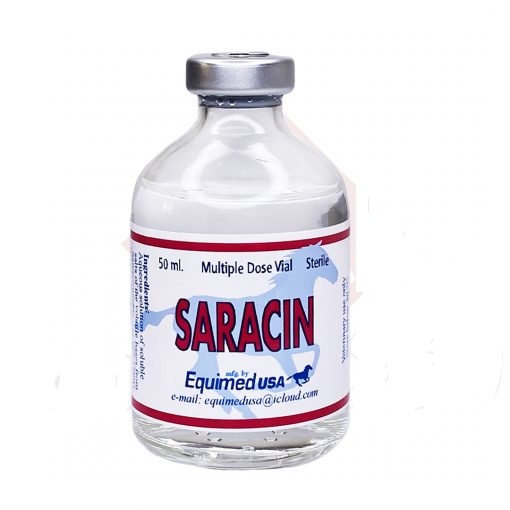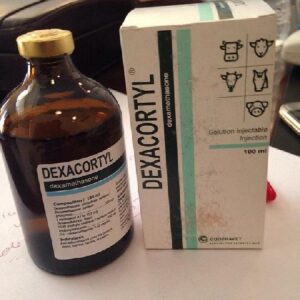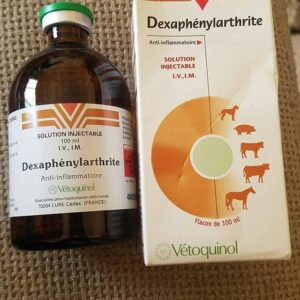Description
Saracin 50ml
Saracin injection is a veterinary medication used primarily in horses. It is known for its role in treating musculoskeletal conditions and managing inflammation and pain injectable solution for muscle discomfort and pain as a cause of lameness and poor performance in the horse is often poorly recognized. While human athletes are readily ably to convey discomfort and pain to physicians, this is obviously not the case with horses, whose muscle injuries often go documented as a cause of lameness.
Saracin injectable solution helps combat lameness in the horse is usually characterized by the resulting gait abnormalities.
- Other muscle problems (stress tetany, synchronous diaphragmatic flutter, exhaustion, post exercise fatigue, tying-up and azoturia) are regarded as specific physiologic disturbances.
- Since muscle injuries typically cause pain and poor performance in human athletes and racing dogs, it should be surmised that similar injuries should be expected in the horse.
There are numerous factors that can lead to muscle strain, including cold temperatures, impaired circulation, muscle fatigue, insufficient training or insufficient warm-up.1 As many human athletes can attest, cold increases muscle tension and can lead to circulatory problems. Performing in the cold can cause early muscle fatigue, which can give rise to incoordination and muscle strain.
Saracin Mechanics of Muscle Fatigue
A variety of problems can contribute to muscle pain in horses, which is broken down into two types:
Primary muscle soreness will usually present itself quite dramatically. Symptoms can include muscle stiffness, sweating, reluctance to move, violent tremors, tucked-up abdomen, or even collapse. Primary muscle problems are often due to an improper function of muscle metabolism, sometimes linked to a genetic component. Primary muscle soreness can be due to a muscle condition such as Polysaccharide Storage Myopathy (PSSM) Type 1 or 2, or Equine Hyperkalemic Periodic Paralysis (HYPP).
Secondary muscle soreness can stem from improperly-fitting equipment, foot soreness or arthritis. Symptoms can be seen in behavioral changes such as a reluctance to go forward, bucking, tail swishing, and changes in overall demeanor. While secondary muscle pain is more common than primary, it can be frustrating to diagnose its exact cause. The multitude of contributing factors include, but are not limited to: poor fitness, dietary deficiencies, improper saddle fit, shoeing problems, or altered movement due to joint pain.3
When muscles are fatigued, they decrease in performance and elasticity, increasing the likelihood of muscle strain. When forced to continue performing under such strain, feedback results in central nervous system incoordination, increasing the likelihood of strain and injury even further.4 An insufficient warm-up of muscles prior to exercise often results in poor circulation during activity and lowered capacity to eliminate muscle waste products. Both of these decrease the muscle’s ability to deliver maximal performance and increase the chances for injury.
As one may have surmised, equine athletes and work horses are exposed to these predisposing factors on a regular basis. Thus, crafting training regimens that progressively increase the workload with a mind toward acclimatizing the horse to the strain gradually is of utmost importance.
Uses Of Saracin Injection
Pain Management: Provides relief from pain associated with joint and musculoskeletal conditions.
Anti-Inflammatory: Reduces inflammation in the affected areas, helping to alleviate symptoms such as swelling and discomfort.
Supportive Care: Often used in conjunction with other treatments to support recovery and improve mobility.
Ingredients Saracin 50 ml
The exact formulation can vary, but Saracin commonly contains: Saracin 50ml
Anti-Inflammatory Agents: Such as corticosteroids or non-steroidal anti-inflammatory drugs (NSAIDs), depending on the product’s specific formulation.
Pain Relievers: Ingredients aimed at managing pain and improving the horse’s comfort.
Administration
Saracin Route Of Administration
Typically administered via intramuscular (IM) or intravenous (IV) injection.
Dosage And Administration
The dosage depends on the specific formulation and the condition being treated.
Dosage Guidelines
Typical Dosage: For a 50 ml vial, dosages may vary.
Side Effects Of Saracin
Common: Possible side effects include localized reactions at the injection site, such as swelling or tenderness.
Serious: More severe side effects are rare but could include systemic reactions or allergic responses. Monitor the horse for any adverse effects and consult a veterinarian if necessary. Saracin 50ml
Precautions
Pre-existing Conditions: Use with caution in horses with pre-existing conditions such as gastrointestinal issues, kidney, or liver disease.
Drug Interactions: Be aware of potential interactions with other medications or supplements. Inform the veterinarian of all other treatments the horse is receiving.
Storage
Storage Conditions: Store in a cool, dry place, typically at room temperature. Avoid freezing.
Incorrect dosage or administration can lead to ineffective treatment or adverse effects.
Monitoring: Regular follow-up with a veterinarian is important to assess the effectiveness of the treatment and manage any potential side effects. Saracin 50ml
Consultation
Veterinarian: Always consult with a veterinarian for specific instructions on dosage, administration, and any concerns about potential side effects or interactions.







Reviews
There are no reviews yet.